The Global Shipping Report
September U.S. Container Import Volumes Increase, Breaking from Traditional Fall Decline
In September 2023, U.S. container import volume increased slightly from August 2023, which is counter to the decline that typically occurs in the last third of the year. Imports from China increased, as did the share of Chinese imports of total U.S. imports. Despite the volume increase, port transit times remained close to their lowest levels for the top West Coast ports since Descartes began tracking them. The top East and Gulf Coast ports, however, are seeing extended transit times. The Panama drought does not appear to be impacting U.S. container import volume, but transit times have increased. The October update of the logistics metrics Descartes is tracking shows some deviation from 2019 results and signs that some of the key challenges to global supply chain performance in 2023 have stabilized, but others have not.
In this Article...
- toc
U.S. container imports flatten.
September 2023 U.S. container import volumes increased 0.3% from August 2023 to 2,203,452 twenty-foot equivalent units (TEUs) (see Figure 1). Versus September 2022, TEU volume was lower by 0.6%, but up 8.0% from pre-pandemic September 2019. The growth in import volume over the first nine months of 2023 is within 2.5% of the same period in 2019.
Figure 1: U.S. Container Import Volume Year-over-Year Comparison
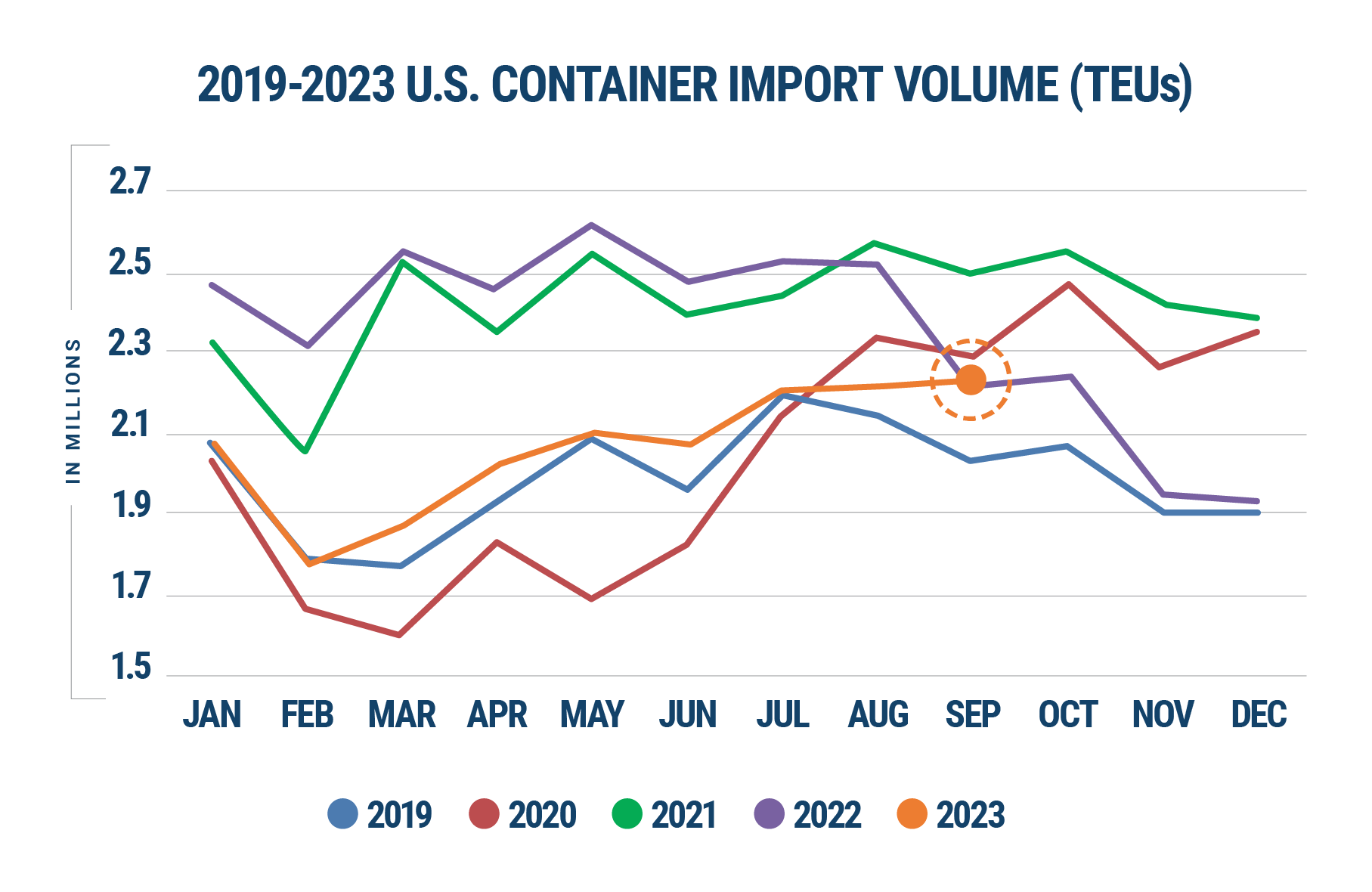
Source: Descartes Datamyne™
The previous six years’ import volume decreased from August to September, consistent with importers winding down shipment volumes for the remainder of the year. However, September 2023 import volume broke that trend and had a very modest increase over August of this year (see Figure 2).
Figure 2: August to September U.S. Container Import Volume Comparison

Source: Descartes Datamyne™
For the top 10 ports, overall U.S. container import volume in September 2023 was up 13,565 TEUs versus August (see Figure 3) with five of the ten ports reporting decreases. The Port of Long Beach (37,363 TEUs) showed the greatest overall container volume increase, while the Ports of Los Angeles (-21,693) and New York/New Jersey (-17,036) had the greatest decrease.
Figure 3: August to September Comparison of Import Volumes at Top 10 U.S. Ports
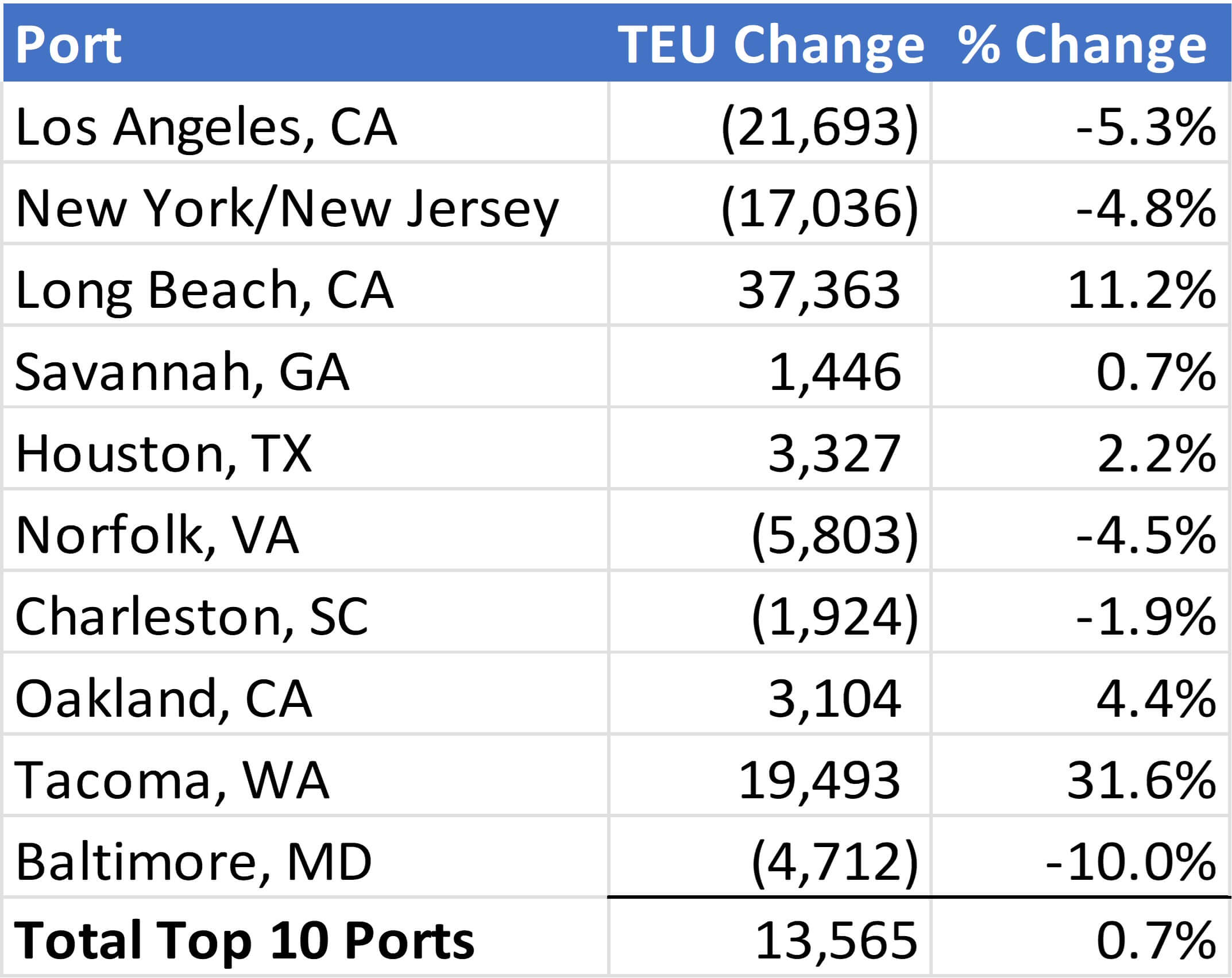
Source: Descartes Datamyne™
Chinese imports in September 2023 increased by 4.2% over August 2023 to 866,762 TEUs, but they were still down 13.6% from the August 2022 high (see Figure 4). China represented 39.3% of the total U.S. container imports in September, an increase of 1.4% from August, but still down 2.2% from the high of 41.5% in February 2022.
Figure 4: September 2022–September 2023 Comparison of U.S. Total and Chinese TEU Container Volume

Source: Descartes Datamyne
For the top 10 countries of origin (CoO), U.S. container import volume in September 2023 increased 1.7% (26,704 TEUs) from the previous month, with China having the greatest volume increase (34,850 TEUs) and Italy (-14,470 TEUs) having the greatest volume decrease (see Figure 5).
Figure 5: August to September Comparison of U.S. Import Volumes from Top 10 Countries of Origin
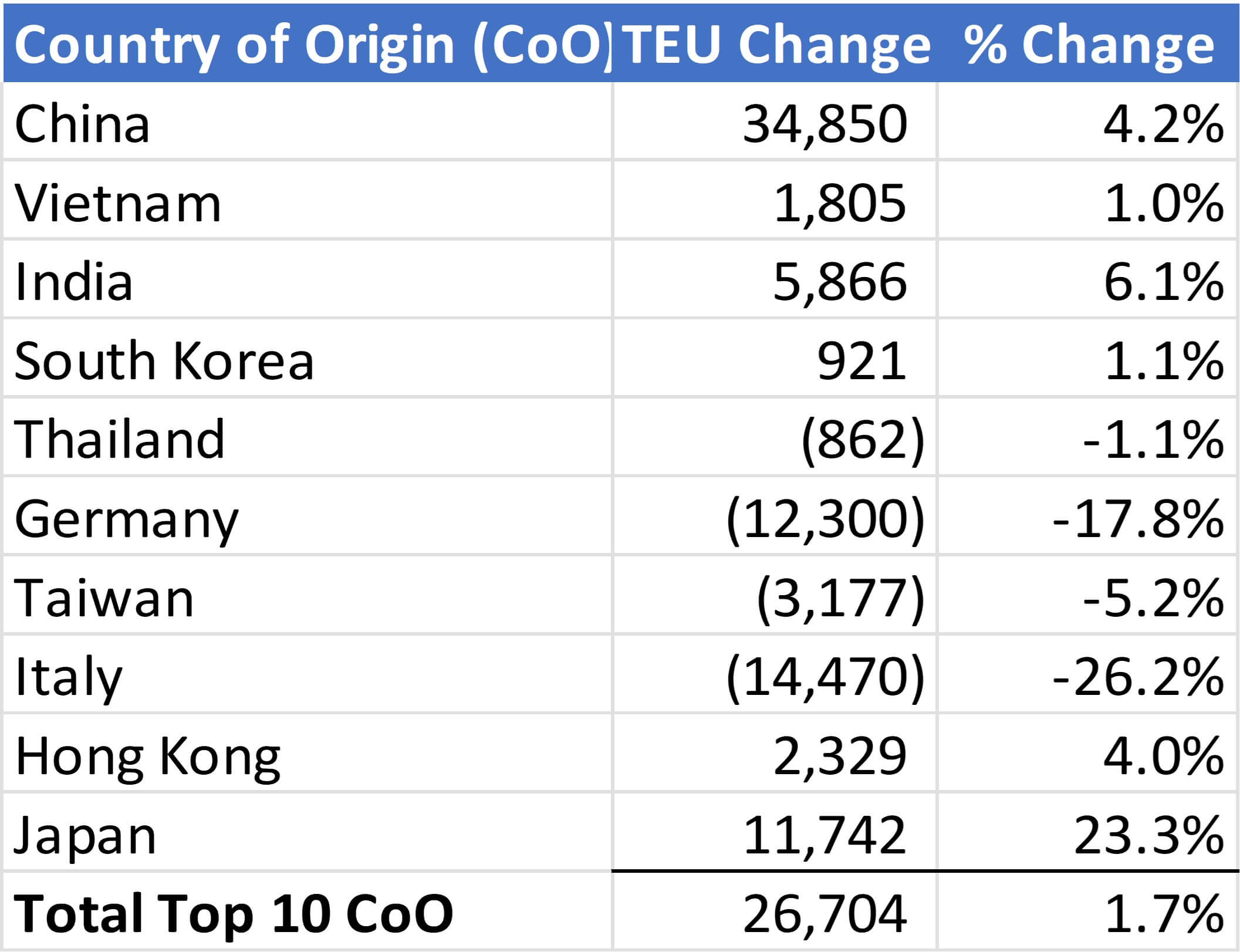
Source: Descartes Datamyne
Top West Coast ports pass top East Coast ports for market share.
In September 2023, the volume share at top West Coast ports increased based upon the significant volume increase at the Ports of Long Beach and Tacoma. Comparing the top five West Coast ports to the top five East and Gulf Coast ports in September 2023 versus August 2023 shows that, of the total import container volume, top West Coast ports increased to 43.3% (up 1.4%) and top East and Gulf Coast ports decreased to 42.1% (down 1.0%). Compared to smaller ports, the top 10 ports’ share in September 2023 increased slightly to 85.4%, up 0.3% versus August 2023 (see Figure 6).
Figure 6: Volume Analysis for Top Ports, West Coast Ports and East and Gulf Coast Ports

Source: Descartes Datamyne
September port transit delays decreased for West Coast ports but increased for East and Gulf Coast ports.
In September 2023, overall port transit delays were mixed. All but one of the top West Coast ports saw transit time reductions versus August 2023 (see Figure 7) and again September was one of the lowest months for delays since Descartes started tracking them. The top East and Gulf Coast ports went in the opposite direction with all ports experiencing transit delay increases. The Port of Los Angeles experienced the greatest decrease (1.2 days) and the Port of Savannah had the greatest increase (2.2) in September 2023 compared to August.
Figure 7: Monthly Average Transit Delays (in days) for the Top 10 Ports
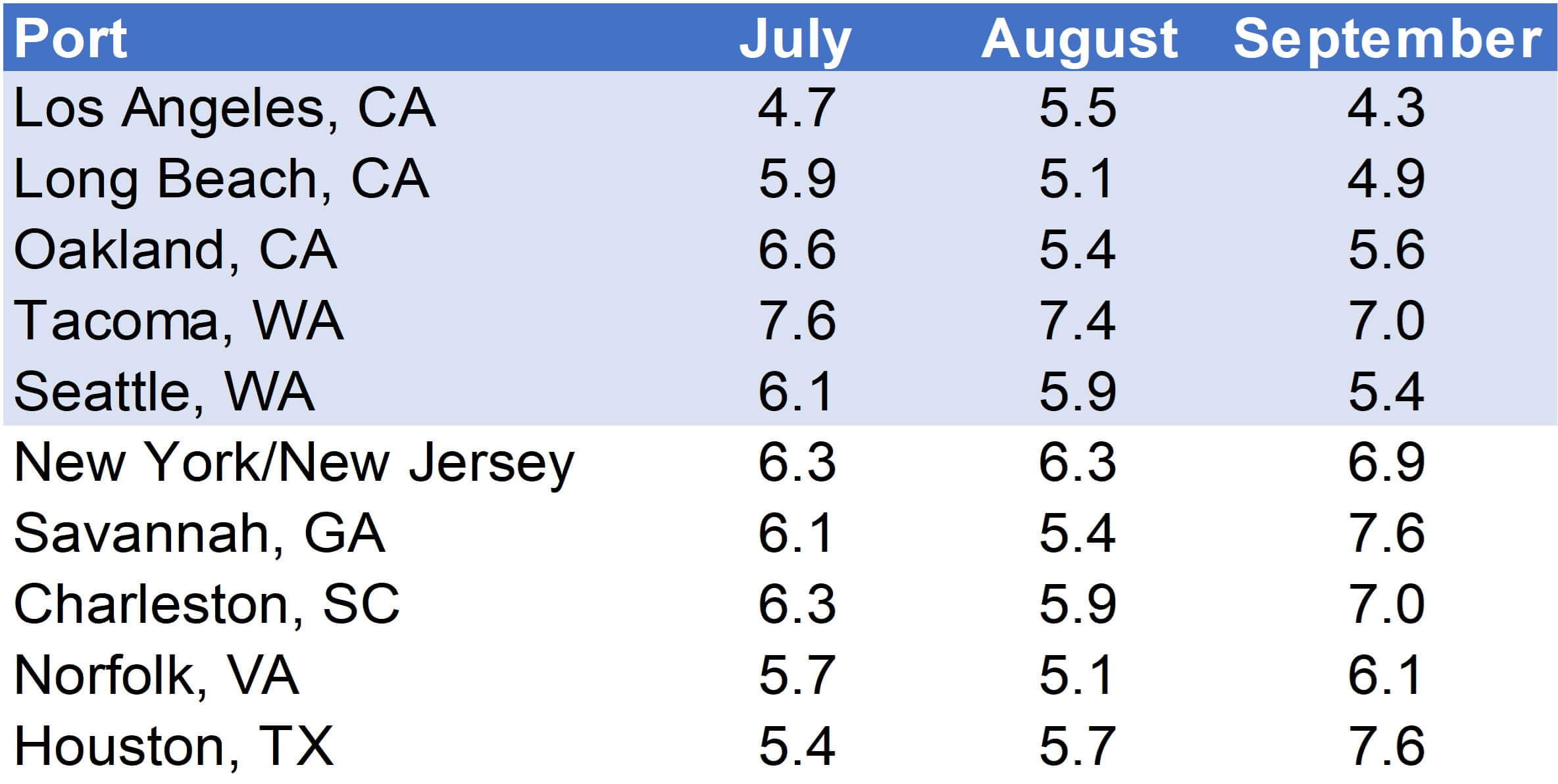
Source: Descartes Datamyne™
Note: Descartes’ definition of port transit delay is the difference as measured in days between the Estimated Arrival Date, which is initially declared on the bill of lading, and the date when Descartes receives the CBP-processed bill of lading.
The drought in Panama still does not appear to be impacting U.S. container import volumes, but transit times have increased.
Panama’s drought continues and the Panama Canal authorities continue to reduce the number of ships passing daily. At this point, the drought does not appear to be impacting U.S. container imports volumes (see Figure 8). Volumes at Gulf Coast ports are following overall U.S. container import volumes and were at their highest for the year in September. However, transit times did increase for the Port of Savannah by 2.2 days in September to 7.6 days.
Figure 8: U.S. Gulf Coast Container Imports for 2023
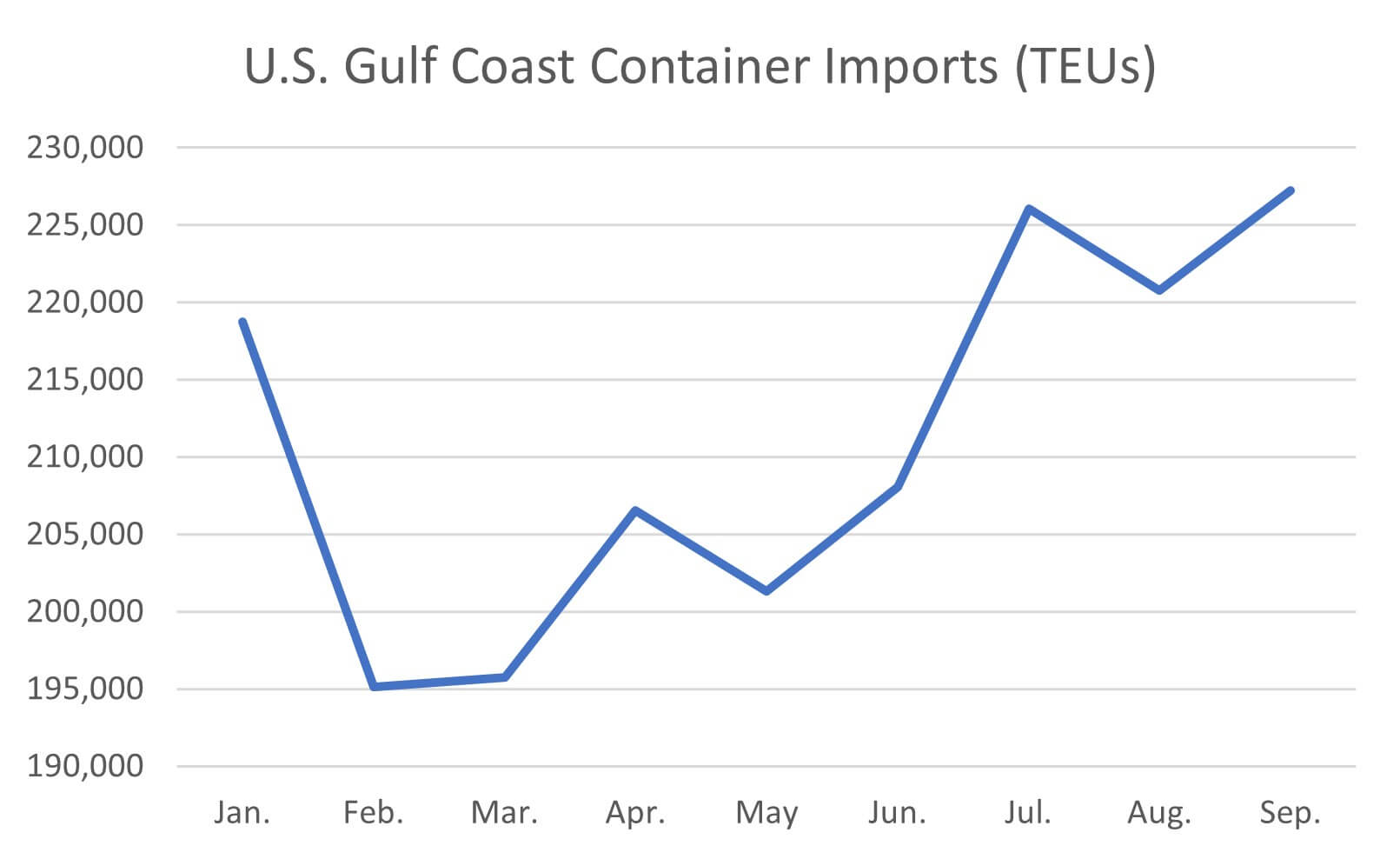
Source: Descartes Datamyne™
To access other articles that track port congestion monthly, visit the
Global Shipping Resource Center
White Papers
Survey Uncovers Supply Chain Strategies of Top Performing Companies
Surviving Peak Season and Beyond: The Essential Guide to Supply Chain Resiliency

Executive Vice President of Industry and Services
Descartes Systems Group
The Must-Read Guide on U.S. Maritime Ports

See the impact port congestion has had on U.S. imports, and gain insights into how to mitigate risks in your supply chain.
Stay Informed. Download the Report.
Managing supply chain risk: what to watch in 2023.
U.S. container import volume increased in September, diverging slightly from the 2019 numbers. There are U.S. container import volume increased in September, diverging slightly from the 2019 numbers. There are positive signs that point to less supply chain turbulence, but emerging signs that there could be disruptions. Here’s what Descartes will be watching to see if global supply chain performance will continue to improve:
- Monthly TEU volumes between 2.4M and 2.6M. This level will continue to stress ports and inland logistics until infrastructure can be enhanced. September U.S. container import volumes are up to 2.2M TEUs, but significantly below this range.
- Port transit wait times. If they decrease, it’s an indication of improved global supply chain efficiencies capabilities or that the demand for goods and logistics services is declining. September port wait time performance was mixed with top West Coast ports seeing transit time decreases, but top East and Gulf Coast ports seeing transit time increases.
- Continuing impact of the pandemic. The spread of COVID subvariants continues to add uncertainty to the trajectory of the pandemic and impact supply chains in unpredictable ways as different countries are affected at different times and for different durations. A new variant of COVID is causing infection rates to rise, which has not yet impacted supply chains and logistics resources but needs to be watched throughout the remainder of the year.
- The economy. The U.S. is an import-driven economy, so economic health is an important indicator of container import volumes. However, there are many indicators that continue to provide conflicting stories. For example, the Federal Reserve increased the borrowing rate to 5.5% to slow inflation which has dropped to 3.7% (as of August 2023). Yet, consumers continue to spend as the inflation adjusted personal consumption expenditures of durable goods continues to rise with August and September 2023 figures being the highest in the last two years.
- Panama Canal-based trade flow. The combination of the drought impacting capacity and the recently ratified International Longshore and Warehouse Union (ILWU) could accelerate the redirection of the one million TEUs that shifted from the West Coast ports during the pandemic. For Gulf Coast ports, container import volume in September was the highest for 2023; however, transit times increased by 1.9 days at the Port of Huston in September.
Consider recommendations to help minimize global shipping challenges.
September 2023 U.S. container import volumes were up versus August 2023, counter to previous years and diverging slightly compared to pre-pandemic 2019 numbers. Port transit times in September remained at lower levels for West Coast ports but increased for East and Gulf Coast ports. The U.S. West Coast labor situation is now resolved, which could facilitate a return of some of the volume that moved to Gulf and East Coast ports, though the continuing drought situation in Panama may hasten that return. This data reaffirms that the pressure on supply chains and logistics operations is continuing to lift, but there are still issues that can cause further disruptions. Descartes will continue to highlight key Descartes Datamyne, U.S. government and industry data in the coming months to provide insight into global shipping. We’ve made a few adjustments to our perspectives and recommendations highlighted in bold:
Short-term:
- Track the spread of COVID variants to determine when they will hit critical parts of the supply chain, especially in China.
- Track ocean shipments and carrier performance as there is still a considerable gap between original ETAs and actual ones.
- Track the Panama Canal situation as the drought may impact shipping capacity and timeliness and even cause rerouting of supply chains.
- Evaluate the impact of inflation and the Russia/Ukraine conflict on logistics costs and capacity constraints. Ensure that key trading partners are not on sanctions lists.
- Focus on keeping the supply chain resources you have, especially drivers. The old adage “a bird in the hand is worth more than two in the bush” definitely applies here. Building trips to reduce stress and improve quality of life to retain drivers is now as or more important than wage increases.
Near-term:
- Continue to look at alternate transportation lanes, including smaller ports, to improve supply chain velocity and resiliency. Total transit time is important, but so is supply chain predictability. Evaluate alternative transportation lanes into the U.S., including entry through northern and southern borders and inland ports.
- For companies importing from Asia, reevaluate trade that was moved away from West Coast ports.
Long-term:
- Evaluate supplier and factory location density to mitigate reliance on over-taxed trade lanes and regions of the globe that have the potential for conflict. Density creates economy of scale but also risk, and the pandemic and subsequent logistics capacity crisis highlights the downside. Conflicts do not happen “overnight” so now is the time to address this potentially business disrupting issue.
Note: This report uses the initial compiled release of U.S. Customs and Border Protection (CBP) data and is subject to revision later by CBP. The revised data can be seen in Descartes Datamyne.
How Descartes Can Help
Descartes Datamyne delivers business intelligence with comprehensive, accurate, up-to-date, import and export information.
Our multinational trade data assets can be used to trace global supply chains and our bill-of-lading trade data – with cross-references to company profiles and customs information – can help businesses identify and qualify new sources. Ask us for a free, no obligation demonstration of our data on a product or trade commodity of your choosing – and keep the custom research we create with our compliments.
